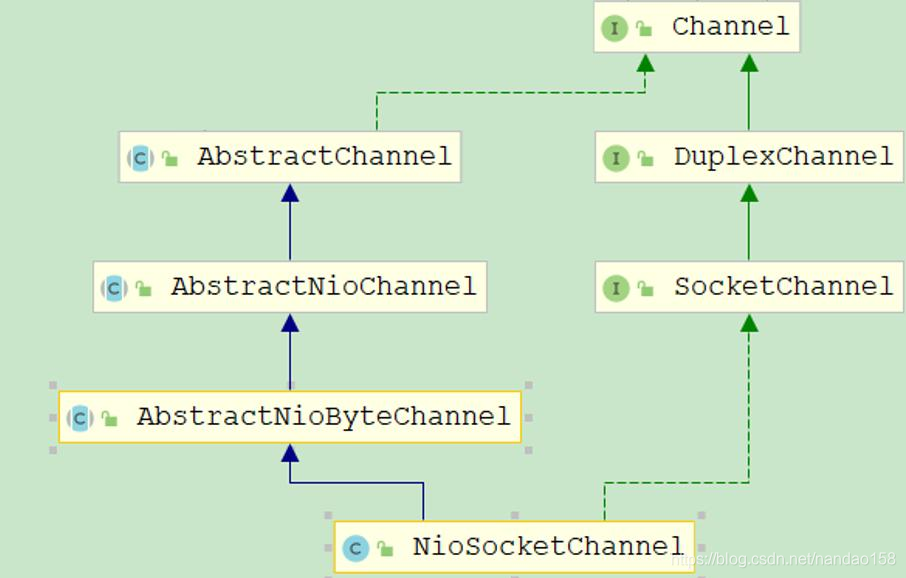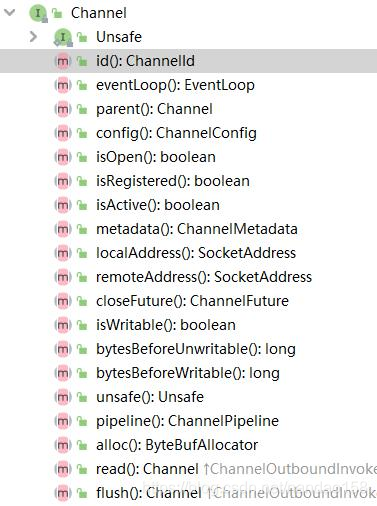


@Override
public ChannelFuture bind(SocketAddress localAddress) {
return pipeline.bind(localAddress);
}
@Override
public ChannelFuture connect(SocketAddress remoteAddress) {
return pipeline.connect(remoteAddress);
}
@Override
public ChannelFuture connect(SocketAddress remoteAddress, SocketAddress localAddress) {
return pipeline.connect(remoteAddress, localAddress);
}
@Override
public ChannelFuture disconnect() {
return pipeline.disconnect();
}
@Override
public ChannelFuture close() {
return pipeline.close();
}
@Override
public ChannelFuture deregister() {
return pipeline.deregister();
}
@Override
public Channel flush() {
pipeline.flush();
return this;
}AbstractChannel 也提供了一些公共 API 的具体实现,例如 localAddress()和 remoteAddress()方法:
@Override
public SocketAddress remoteAddress() {
SocketAddress remoteAddress = this.remoteAddress;
if (remoteAddress == null) {
try {
this.remoteAddress = remoteAddress = unsafe().remoteAddress();
} catch (Throwable t) {
// Sometimes fails on a closed socket in Windows.
return null;
}
}
return remoteAddress;
}首先从成员变量中获取,如果第一次调用为空,需要通过 unsafe 的 remoteAddress 获取, 它是个抽象方法,具体由对应的 Channel 子类实现。 从这个 AbstractChannel 来看,Unsafe 系列的类非常重要,我们将在后面说明。
private static final InternalLogger logger =
InternalLoggerFactory.getInstance(AbstractNioChannel.class);
private static final ClosedChannelException DO_CLOSE_CLOSED_CHANNEL_EXCEPTION = ThrowableUtil.unknownStackTrace(
new ClosedChannelException(), AbstractNioChannel.class, "doClose()");
private final SelectableChannel ch;
protected final int readInterestOp;
volatile SelectionKey selectionKey;
boolean readPending;
private final Runnable clearReadPendingRunnable = new Runnable() {
@Override
public void run() {
clearReadPending0();
}
};
/**
* The future of the current connection attempt. If not null, subsequent
* connection attempts will fail.
*/
private ChannelPromise connectPromise;
private ScheduledFuture<?> connectTimeoutFuture;
private SocketAddress requestedRemoteAddress;由于 NioSocketChannel 和 NioServerSocketChannel 需要共用,所以定义了一个 java.nio.SocketChannel 和 java.nio.ServerSocketChannel 的公共父类 SelectableChannel(由 JDK 定义),用于设置 SelectableChannel 参数和进行 IO 操作。 第二个参数是 readInterestOp,表示当前的 Channel 所关注的事件,不过从名字上来说, 我们可以认为这个 AbstractNioChannel 关注的事件是读。 随后定义了一个 volatile 修饰的 SelectionKey,该 SelectionKey 是 Channel 注册到 EventLoop 后返回的选择键。由于 Channel 会面临多个业务线程的并发写操作,当SelectionKey 由 SelectionKey 修改之后,为了能让其他业务线程感知到变化,所以需要使用 volatile 保证修改的可见性。 很明显,上述的成员变量都是和 NIO 操作相关的。 最后定义了代表连接操作结果的 ChannelPromise 以及连接超时定时器 ScheduledFuture 和请求的通信地址信息。
protected AbstractNioChannel(Channel parent, SelectableChannel ch, int readInterestOp) {
super(parent);
this.ch = ch;
this.readInterestOp = readInterestOp;
try {
ch.configureBlocking(false);
} catch (IOException e) {
try {
ch.close();
} catch (IOException e2) {
if (logger.isWarnEnabled()) {
logger.warn(
"Failed to close a partially initialized socket.", e2);
}
}
throw new ChannelException("Failed to enter non-blocking mode.", e);
}
}这个类的构造方法的用意很明显,让 AbstractNioChanne 中的成员变量实例化,并且设置 SelectableChannel 为非阻塞模式。
@Override
protected void doRegister() throws Exception {
boolean selected = false;
for (;;) {
try {
selectionKey = javaChannel().register(eventLoop().unwrappedSelector(), 0, this);
return;
} catch (CancelledKeyException e) {
if (!selected) {
// Force the Selector to select now as the "canceled" SelectionKey may still be
// cached and not removed because no Select.select(..) operation was called yet.
eventLoop().selectNow();
selected = true;
} else {
// We forced a select operation on the selector before but the SelectionKey is still cached
// for whatever reason. JDK bug ?
throw e;
}
}
}
}首先是 Channel 的注册,定义一个布尔类型的局部变量 selected 来标识注册操作是否成功,调用 SelectableChannel 的 register 方法,将当前的 Channel 注册到 EventLoop 的多路 复用器上。 注册 Channel 的时候需要指定监听的网络操作位来表示 Channel 对哪几类网络事件感兴趣,前面我们说过在向 Selector 对象注册感兴趣的事件时。
@Override
protected void doBeginRead() throws Exception {
// Channel.read() or ChannelHandlerContext.read() was called
final SelectionKey selectionKey = this.selectionKey;
if (!selectionKey.isValid()) {
return;
}
readPending = true;
final int interestOps = selectionKey.interestOps();
if ((interestOps & readInterestOp) == 0) {
selectionKey.interestOps(interestOps | readInterestOp);
}
}这个方法的作用是在准备处理读操作之前需要设置网路操作位为读。 先判断下 Channel 是否关闭,如果处于关闭中,则直接返回。获取当前的 SelectionKey 进行判断,如果可用,说明 Channel 当前状态正常,则可以进行正常的操作位修改。 将 SelectionKey 当前的操作位与读操作位进行按位与操作,如果等于 0,说明目前并没有设置读操作位,通过 interestOps | readInterestOp 设置读操作位,最后调用 selectionKey 的 interestOps 方法重新设置通道的网络操作位,这样就可以监听网络的读事件了。 回顾一下,readInterestOp 是在哪里被设置为读相关的呢?在 AbstractNioChannel 的构 造方法里,由参数传入,这个构造方法的调用,则是在 AbstractNioChannel 的子类AbstractNioByteChannel 中,我们很快就会看到。

protected AbstractNioByteChannel(Channel parent, SelectableChannel ch) {
super(parent, ch, SelectionKey.OP_READ);
}
这个方法里调用了父类 AbstractNioChannel 的构造方法,并且设置关注的事件为读事件 (SelectionKey.OP_READ)
@Override
protected void doWrite(ChannelOutboundBuffer in) throws Exception {
int writeSpinCount = config().getWriteSpinCount();
do {
Object msg = in.current();
if (msg == null) {
// Wrote all messages.
clearOpWrite();
// Directly return here so incompleteWrite(...) is not called.
return;
}
writeSpinCount -= doWriteInternal(in, msg);
} while (writeSpinCount > 0);
incompleteWrite(writeSpinCount < 0);
}首先设置了一个变量 writeSpinCount,表示写操作的最大循环计数,writeSpinCount 缺省为 16 次(设置最大循环次数的原因是当循环发送的时候,IO 线程会一直尝试进行写操作, 此时 I/O 线程无法处理其他的 I/O 操作,例如读新的消息或者执行定时任务和 NioTask 等,如果网络 I/O 阻塞或者对方接收消息太慢,可能会导致线程假死)。 从发送消息缓存 ChannelOutboundBuffer 弹出一条消息,判断该消息是否为空,如果为空,说明发送消息缓存 ChannelOutboundBuffer 中所有待发送的消息都已经发送完成,清除写操作在 selector 上的注册,然后退出循环。清除写操作注册的 clearOpWrite 方法实现如下:
protected final void clearOpWrite() {
final SelectionKey key = selectionKey();
// Check first if the key is still valid as it may be canceled as part of the deregistration
// from the EventLoop
// See https://github.com/netty/netty/issues/2104
if (!key.isValid()) {
return;
}
final int interestOps = key.interestOps();
if ((interestOps & SelectionKey.OP_WRITE) != 0) {
key.interestOps(interestOps & ~SelectionKey.OP_WRITE);
}
}从当前 SelectionKey 中获取网络操作位,然后与 SelectionKey.OP_WRITE 做按位与,如果不等于 0,说明当前的 SelectionKey 是 isWritable 的,需要清除写操作位。清除方法很简单,就是 SelectionKey.OP_WRITE 取非之后与原操作位做按位与操作,清除 SelectionKey 的写操作位。如果需要发送的消息不为空,则继续处理,具体的处理方法是 doWriteInternal,
private int doWriteInternal(ChannelOutboundBuffer in, Object msg) throws Exception {
if (msg instanceof ByteBuf) {
ByteBuf buf = (ByteBuf) msg;
if (!buf.isReadable()) {
in.remove();
return 0;
}
final int localFlushedAmount = doWriteBytes(buf);
if (localFlushedAmount > 0) {
in.progress(localFlushedAmount);
if (!buf.isReadable()) {
in.remove();
}
return 1;
}
} else if (msg instanceof FileRegion) {
FileRegion region = (FileRegion) msg;
if (region.transferred() >= region.count()) {
in.remove();
return 0;
}
long localFlushedAmount = doWriteFileRegion(region);
if (localFlushedAmount > 0) {
in.progress(localFlushedAmount);
if (region.transferred() >= region.count()) {
in.remove();
}
return 1;
}
} else {
// Should not reach here.
throw new Error();
}
return WRITE_STATUS_SNDBUF_FULL;
}这个方法有两个分支,一个分支判断需要发送的消息是否是 ByteBuf 类型,另一个分支判断消息发送的是文件传输类型,两者的实现原理很相似,我们主要看 ByteBuf 类型。 首先判断需要发送的消息是否是 ByteBuf 类型,如果是,则进行强制类型转换,将其转换成 ByteBuf 类型,判断当前消息的可读字节数是否为 0,如果为 0,说明该消息不可读, 需要丢弃。从发送消息缓存中删除该消息,退出到外部循环继续处理其他的消息。调用 doWriteBytes 进行消息发送,不同的 Channel 子类有不同的实现,因此它是抽象方法,但其实也只有两个实现,分别对应着 TCP 和 UDP。 如果发送的字节数大于 0,更新发送消息缓存 ChannelOutboundBuffer 里的发送进度信息,同时判断当前消息的可读字节数是否为 0,如果为 0,说明该消息已经处理完成,从发送消息缓存 ChannelOutboundBuffer 中删除该消息,退出到外部循环继续处理其他的消息。如果调用 doWriteBytes 发送消息,发送的字节数为 0,则返回一个 WRITE_STATUS_SNDBUF_FULL = Integer.MAX_VALUE 值。 一般只有当前 Socket 缓冲区写满了,无法再继续发送数据的时候才会返回0(Socket 的 Buffer 已满)。 如果继续循环发送也还是无法写入的,这时只见返回一个比较大值,会直接退出循环发送的,稍后再尝试写入。方法的返回并且返回值表示本次写操作成功的次数。回到 doWrite 方法,发送消息缓存 ChannelOutboundBuffer 没写完,需要循环继续处理,根据 doWriteInternal 方法的返回值对写操作的循环计数器 writeSpinCount 进行扣减,如果没 有超过最大循环计数,继续从发送消息缓存 ChannelOutboundBuffer 中读取数据进行处理。接下来调用 incompleteWrite(writeSpinCount < 0);方法,看这个方法的名字我们可以知道, 它的含义是发送消息缓存 ChannelOutboundBuffer 还有数据未完成时的处理,这个方法的参数接受一个 writeSpinCount 和 0 的比较值,无非就是 true 和 fasle。
protected final void incompleteWrite(boolean setOpWrite) {
// Did not write completely.
if (setOpWrite) {
setOpWrite();
} else {
// It is possible that we have set the write OP, woken up by NIO because the socket is writable, and then
// use our write quantum. In this case we no longer want to set the write OP because the socket is still
// writable (as far as we know). We will find out next time we attempt to write if the socket is writable
// and set the write OP if necessary.
clearOpWrite();
// Schedule flush again later so other tasks can be picked up in the meantime
eventLoop().execute(flushTask);
}
}如果 writeSpinCount 小于 0(writeSpinCount 什么时候才会出现小于 0 呢?上面已经分析过,如果调用 doWriteBytes 发送消息,发送的字节数为 0,则返回一个 WRITE_STATUS_SNDBUF_FULL = Integer.MAX_VALUE 值。Socket 的 Buffer 已经写满,无法再继续发送数据),为 true,调用 setOpWrite() 方法,在 Selector 上注册写标识。在首先判断 SelectionKey 是否有效,然后检查 Selector 上是否注册了 OP_WRITE 标识,如果没有则注册上,这样的话在 selecto 下次轮询的时候,将再次执行写操作。 如果 writeSpinCount 大于等于 0(大于 0 一般不可能,因为上面退出的循环条件是 writeSpinCount >0),则清除 Selector 上注册的写标识,并且启动独立的 Runnable,将其加入到 EventLoop 中执行,Runnable 里的实现很简单,就是调用 flush()方法将数据强制刷出。 这段代码意义何在?这是 Netty 的机制之一,作用是让每个连接默认最多连续写 16 次 (writeSpinCount 的缺省值),超过 16 次,即使还有数据以及缓冲区还有空闲也暂时不处理了,先处理下一个连接。这个 Channel 上没有写完的数据,就直接 schedule 一个 task 来 继续写,空闲时继续刷新,而不是用注册写事件来触发,推测 Netty 的设计思路是,这个Channel 可能只是因为自旋次数少,引起的数据发送不完全,而无需等待 selector,干脆就 在空闲时继续处理这个 Channel 上的数据。
private static final ChannelMetadata METADATA = new ChannelMetadata(false, 16);
private static final SelectorProvider DEFAULT_SELECTOR_PROVIDER = SelectorProvider.provider();
private static final InternalLogger logger = InternalLoggerFactory.getInstance(NioServerSocketChannel.class);
private static ServerSocketChannel newSocket(SelectorProvider provider) {
try {
/**
* Use the {@link SelectorProvider} to open {@link SocketChannel} and so remove condition in
* {@link SelectorProvider#provider()} which is called by each ServerSocketChannel.open() otherwise.
*
* See <a href="https://github.com/netty/netty/issues/2308">#2308</a>.
*/
return provider.openServerSocketChannel();
} catch (IOException e) {
throw new ChannelException(
"Failed to open a server socket.", e);
}
}首先创建了静态的 ChannelMetadata 成员变量,然后定义了 ServerSocketChannelConfig 用于配置 ServerSocketChannel 的 TCP 参数。静态的 newSocket 方法用于通过
public NioServerSocketChannel(ServerSocketChannel channel) {
super(null, channel, SelectionKey.OP_ACCEPT);
config = new NioServerSocketChannelConfig(this, javaChannel().socket());
}调用了父类的父类(AbstractNioChannel)的构造方法,将 NioServerSocketChannel 的所应该关注的事件设置为 OP_ACCEPT。当然,从前面我们对 AbstractNioChannel 的解读我们看到,进行实际的设置是在 doBeginRead 方法中。
@Override
public boolean isActive() {
return javaChannel().socket().isBound();
}
@Override
public InetSocketAddress remoteAddress() {
return null;
}
@Override
protected ServerSocketChannel javaChannel() {
return (ServerSocketChannel) super.javaChannel();
}
@Override
protected SocketAddress localAddress0() {
return SocketUtils.localSocketAddress(javaChannel().socket());
}
@Override
protected void doBind(SocketAddress localAddress) throws Exception {
if (PlatformDependent.javaVersion() >= 7) {
javaChannel().bind(localAddress, config.getBacklog());
} else {
javaChannel().socket().bind(localAddress, config.getBacklog());
}
}这几个方法都很简单,isActive 通过 java.net.ServerSocket 的 isBound 方法判断服务端监听端口是否处于绑定状态,它的 remoteAddress 为空。javaChannel 的实现是 java.nio.ServerSocketChannel。doBind 中服务端在进行端口绑定的时候,进行了 JDK 版本的判定,并且可以指定 backlog,也就是允许客户端排队的最大长度。 doReadMessages(List<Object> buf)方法在父类 AbstractNioMessageChannel 进行了抽象定义,在这个类中有具体的实现,用来处理客户端的连接
@Override
protected int doReadMessages(List<Object> buf) throws Exception {
SocketChannel ch = SocketUtils.accept(javaChannel());
try {
if (ch != null) {
buf.add(new NioSocketChannel(this, ch));
return 1;
}
} catch (Throwable t) {
logger.warn("Failed to create a new channel from an accepted socket.", t);
try {
ch.close();
} catch (Throwable t2) {
logger.warn("Failed to close a socket.", t2);
}
}
return 0;
}首先通过 SocketUtils 的工具类 的 accept 接收新的客户端连接,如果 SocketChannel 不 为空,则创建新的 NioSocketChannel,并将其加入到 List<Object> buf 中,最后返回 1,表示 服务端消息读取成功。很明显,对于 NioServerSocketChannel,它的读取操作就是接收客户端的连接,创建 NioSocketChannel 对象。 至于其他与服务端 Channel 无关的接口定义,由于这些方法是客户端 Channel 相关的,因此,对于服务端 Channel 无须实现。如果这些方法被误调,则返回UnsupportedOperationException 异常。
@Override
protected boolean doConnect(
SocketAddress remoteAddress, SocketAddress localAddress) throws Exception {
throw new UnsupportedOperationException();
}
@Override
protected void doFinishConnect() throws Exception {
throw new UnsupportedOperationException();
}八、NioSocketChannel NioSocketChannel 比较重要,因为具体的网络读写都是在 NioSocketChannel 发生的。 1、连接方法 doConnect
@Override
protected boolean doConnect(SocketAddress remoteAddress, SocketAddress localAddress) throws Exception {
if (localAddress != null) {
doBind0(localAddress);
}
boolean success = false;
try {
boolean connected = SocketUtils.connect(javaChannel(), remoteAddress);
if (!connected) {
selectionKey().interestOps(SelectionKey.OP_CONNECT);
}
success = true;
return connected;
} finally {
if (!success) {
doClose();
}
}
}判断本地 Socket 地址是否为空,如果不为空则调用 doBind0 方法,当然本质上是调用 JDK 的相关方法绑定本地地址。接下来,则继续调用 java.nio.channels.SocketChannel.connect(SocketAddress remote)发起 TCP 连接。 2、之后对连接结果进行判断,连接结果有以下三种可能。
@Override
protected void doWrite(ChannelOutboundBuffer in) throws Exception {
SocketChannel ch = javaChannel();
int writeSpinCount = config().getWriteSpinCount();
do {
if (in.isEmpty()) {
//首先对发送消息缓存 ChannelOutboundBuffer 检查,如果为空,说明发送消息缓存 ChannelOutboundBuffer
//中所有待发送的消息都已经发送完成,清除写操作在 selector 上的注册,然后退出本方法。
// All written so clear OP_WRITE
clearOpWrite();
// Directly return here so incompleteWrite(...) is not called.
return;
}
// Ensure the pending writes are made of ByteBufs only.
//接下来获取 ChannelOutboundBuffer 中 ByteBuf 的数量,在获取的时候会通过(1024, maxBytesPerGatheringWrite)
//控制获取的 ByteBuf 的最大数量和最大字节数。 根据获取的 ByteBuf 的数量分情况进行处理:
int maxBytesPerGatheringWrite = ((NioSocketChannelConfig) config).getMaxBytesPerGatheringWrite();
ByteBuffer[] nioBuffers = in.nioBuffers(1024, maxBytesPerGatheringWrite);
int nioBufferCnt = in.nioBufferCount();
// Always us nioBuffers() to workaround data-corruption.
// See https://github.com/netty/netty/issues/2761
switch (nioBufferCnt) {
case 0:
//源码上注释的意思是:除了 ByteBuffers 之外,我们还有其他要写的东西,因此可以回退到普通写操作,它的意思是如果 nioBuffers 个数为 0,
//可能是其他内容的数据,比如 FileRegion,则调用父类 AbstractNioByteChannel 的 doWriter0 方法去写。
// We have something else beside ByteBuffers to write so fallback to normal writes.
writeSpinCount -= doWrite0(in);
break;
case 1: {
//表示如果只有一个 ByteBuffer,则不需要使用 nio 的 gathering write 去写,而是直接使 用 SocketChannel 的 write 方法,
//如果写入字节数小于等于 0,就直接注册写事件,退出方法, 等待下次 select 时,继续写。 如果写入了一定量的数据,
// 则调整最大字节数,并将已经写入的数据从发送消息缓存 ChannelOutboundBuffer 中移除,然后开始新的一轮循环写。
// Only one ByteBuf so use non-gathering write
// Zero length buffers are not added to nioBuffers by ChannelOutboundBuffer, so there is no need
// to check if the total size of all the buffers is non-zero.
ByteBuffer buffer = nioBuffers[0];
int attemptedBytes = buffer.remaining();
final int localWrittenBytes = ch.write(buffer);
if (localWrittenBytes <= 0) {
incompleteWrite(true);
return;
}
adjustMaxBytesPerGatheringWrite(attemptedBytes, localWrittenBytes, maxBytesPerGatheringWrite);
in.removeBytes(localWrittenBytes);
--writeSpinCount;
break;
}
default: {
//如果 ByteBuf 个数大于 1,则使用 Nio 的 gather 聚合 Buffer 写入,一次就可以写入多个 Buffer 的数据。在实现上,和只有一个 ByteBuffer 时没有太大差别。
// Zero length buffers are not added to nioBuffers by ChannelOutboundBuffer, so there is no need
// to check if the total size of all the buffers is non-zero.
// We limit the max amount to int above so cast is safe
long attemptedBytes = in.nioBufferSize();
final long localWrittenBytes = ch.write(nioBuffers, 0, nioBufferCnt);
if (localWrittenBytes <= 0) {
incompleteWrite(true);
return;
}
// Casting to int is safe because we limit the total amount of data in the nioBuffers to int above.
adjustMaxBytesPerGatheringWrite((int) attemptedBytes, (int) localWrittenBytes,
maxBytesPerGatheringWrite);
in.removeBytes(localWrittenBytes);
--writeSpinCount;
break;
}
}
} while (writeSpinCount > 0);
incompleteWrite(writeSpinCount < 0);
}
@Override
protected int doReadBytes(ByteBuf byteBuf) throws Exception {
final RecvByteBufAllocator.Handle allocHandle = unsafe().recvBufAllocHandle();
allocHandle.attemptedBytesRead(byteBuf.writableBytes());
return byteBuf.writeBytes(javaChannel(), allocHandle.attemptedBytesRead());
}
@Override
protected int doWriteBytes(ByteBuf buf) throws Exception {
final int expectedWrittenBytes = buf.readableBytes();
return buf.readBytes(javaChannel(), expectedWrittenBytes);
}
@Override
protected long doWriteFileRegion(FileRegion region) throws Exception {
final long position = region.transferred();
return region.transferTo(javaChannel(), position);
}总的来说,是基于 NIO 的 SocketChannel 和 Netty 的 ByteBuf 封装而成,ByteBuf 的源码分析,我们后面会讲到。 唯一需要注意的是,在写文件块 doWriteFileRegion 方法中,使用了 JDK 提供的零拷贝技术
Channel 接口实现类系列源码之NioServerSocketChannel类分析完成,下篇分析Unsafe 接口实现类相关源码,敬请期待!

























 203
203

 被折叠的 条评论
为什么被折叠?
被折叠的 条评论
为什么被折叠?










